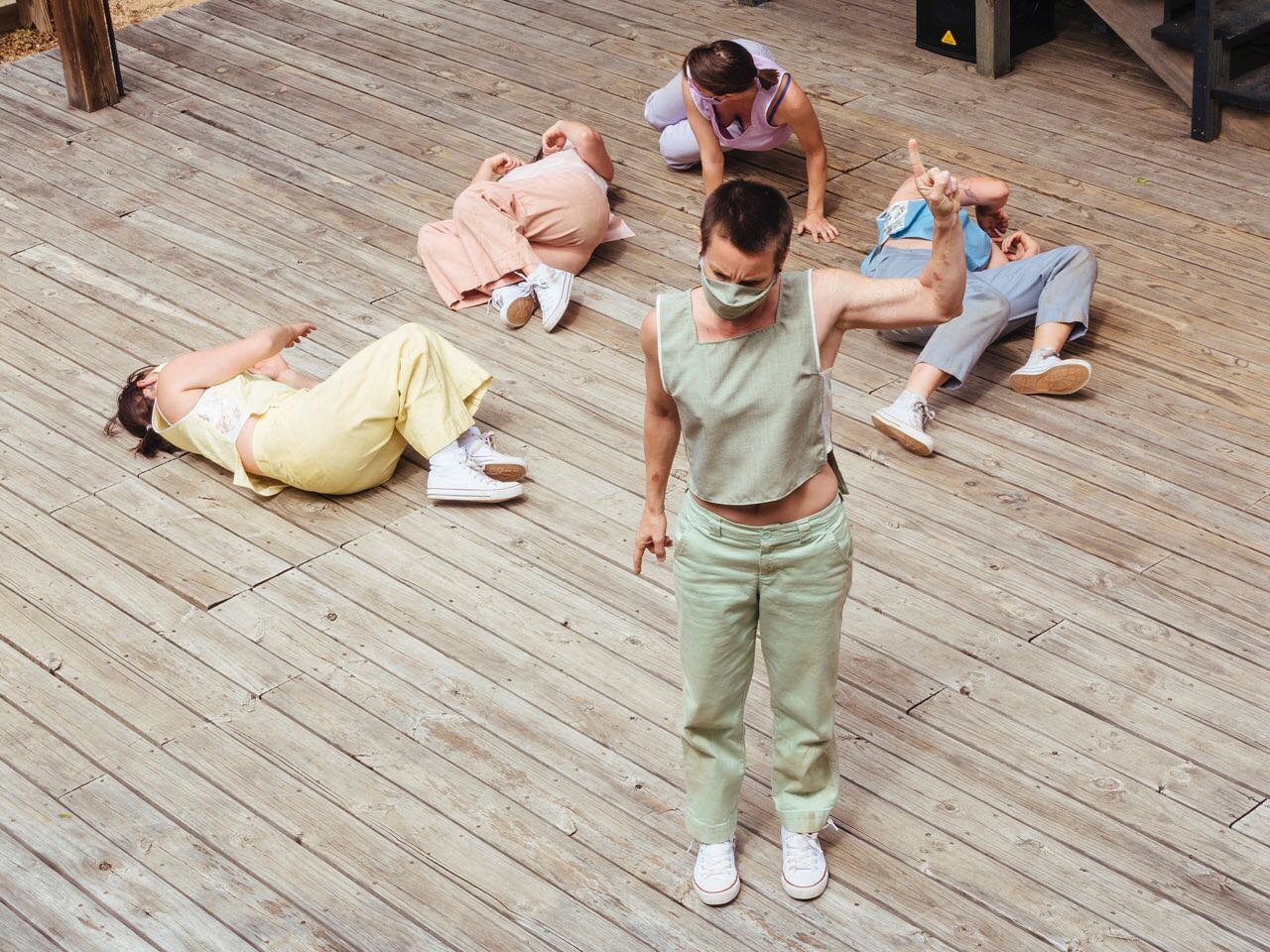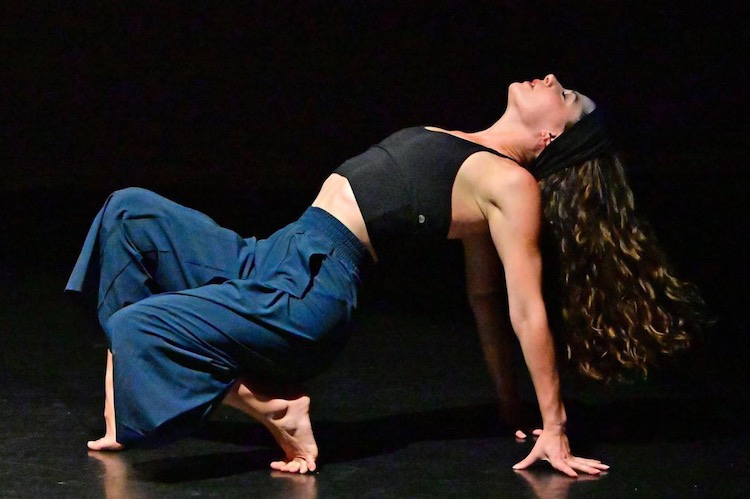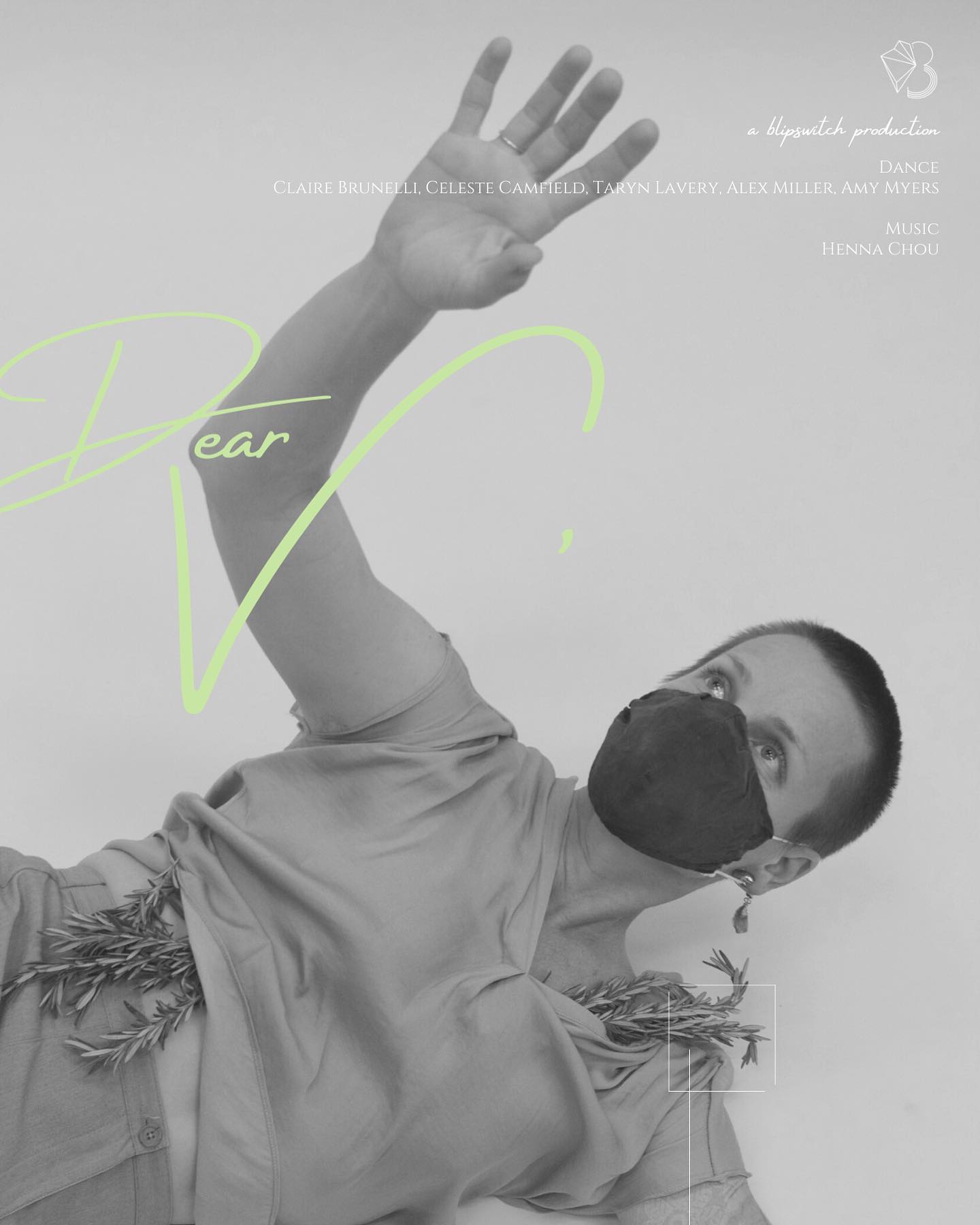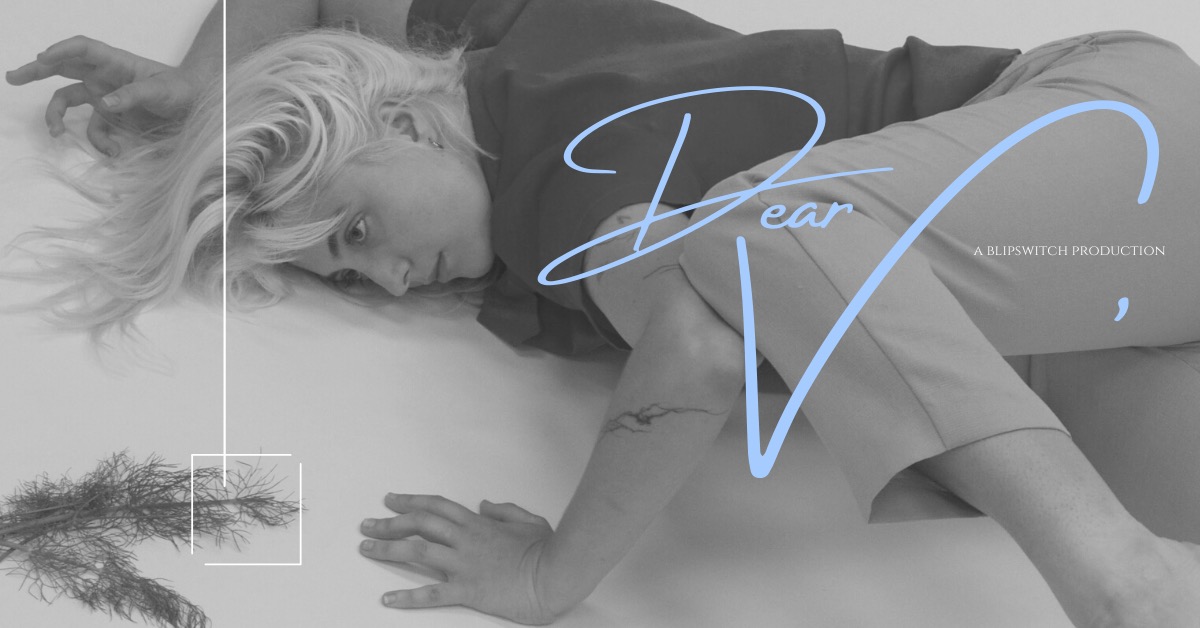Review: DEAR V., by Blipswitch at the Curtain Theatre
by David Glen Robinson

At the Curtain Theatre in far west forested Austin, Texas
The pandemic is dead, long live performance in live!
All the permutations and iterations of flickering streaming shows comprised but a single candle against the dark, a needed guide to light the way to our artistic return. The bold performers of Blipswitch have struck out into the light of day with their show Dear V,. Obeying the protocols, the dancers of Blipswitch performed mask to mask, audience to performers, while driving their artistic exertions beyond the constrictions and restrictions imposed by the great viral attack.
Arriving at the Curtain Theatre for Dear V, one hurries to park and then to enter the theatre. Only later does one realize that one has been embraced by a forest, by spreading walnut trees, immensely high and profoundly gnarled, a grove of monumental living sculpture framed by grandmother cypresses along the shore of Lake Austin. This is The Baron’s Men’s own Forest of Arden. The natural setting and the Curtain Theatre’s half-scale evocation of the historic Globe Theatre in a land faraway symbolize Blipswitch’s program declaration that the show “embraces the obscurity and contradictions of the human experience.”
Blipswitch’s Dear V, is an almost signature work of contemporary dance, featuring earmarks that set contemporary dance apart from modern dance and other dance art.

First, the work proceeds from start to finish as a unified whole. No breaks. No division into separate pieces with titles and differing soundtracks, although the soundtrack in Dear V, a live performance by Henna Chou and Drew Silverman, gave us variegated soundscapes integrated into the whole.
Second, the work is heavily abstract and not didactic or narrative. In many contemporary dance shows, this quality may limit intellectual and esthetic accessibility. For those willing to take in new sets of perceptions, images, and visions without prejudgment, the rewards are considerable. The appreciative audience feels taken on journeys along new pathways of thought and meaning.
Freedom is linked to abstraction. The audience is never instructed in definite, precise meanings. Instead, perceivers are invited to derive their own meanings. Blipswitch certainly advocates this approach.
Choreographers enjoy listening to what others make of their shows, particularly when the accounts are at wide variance from the choreographer’s initial vision. Many refuse to reveal their inspirations for a work in order to avoid entraining audience perceptions along restrictive channels. Choreographers don’t want you to read their minds; they want you to read your own mind. And then, after the show, they want to discuss and share the collective art, with the audience as co-creators.
Few art forms embrace such freedom while adhering to disciplined and athletic movement technique (often derived from modern technique and ballet). Dancers skilled in this field laugh and comment that if there is no technique, it's performance art, not dance.
Dear V, gave us fifty minutes of nonstop athletic dance, all absorbingly abstract. There you have it: contemporary dance. A primary virtue of the performance was the use of every square inch of the multilevel performance space. The dancers occasionally moved in linked chains around the proscenium front and back again. Similar movements up the upstage stairs and down again.
What may become the hallmark of Blipswitch is the perfection of unison movement. The dancers found many non-repeating ways of initiating unison from differing spatial levels, often without eye contact and never a sound cue. Every unison passage was perfectly timed, no catch-up steps observed. Allied with the attention to unison was the initiation of solos, duets, and additional segments. The new combinations were never anticipated. This aspect showed thoughtful choreography that kept the dance fresh and surprising. The success here is that the fifty-minute performance seemed like twenty-five minutes, with the audience still wanting more by the end.
The well-rehearsed dancers were Alex Miller, Taryn Lavery, Amy Myers, Anna Claire Brunelli, and Celeste Camfield. They presented a unified group look in the color-coordinated pastel costumes designed and fabricated by the multitalented Taryn Lavery. Everyone was in white Converse hightops. The performance began with all of them draped supine and inert on the various levels of the Elizabethan stage. The movement passages grew from that.
 Anna Claire Brunelli in peach (pink?) seemed to reach repeatedly for star status and preeminence with her open, engaged face and quirky accent movements. She and the ensemble used many literal hand and arm gestures to emphasize and layer the work, gestures choreographer Kathy Dunn Hamrick calls micro-movements. Brunelli brought laughter more than once when she walked two fingers along the boards.
Anna Claire Brunelli in peach (pink?) seemed to reach repeatedly for star status and preeminence with her open, engaged face and quirky accent movements. She and the ensemble used many literal hand and arm gestures to emphasize and layer the work, gestures choreographer Kathy Dunn Hamrick calls micro-movements. Brunelli brought laughter more than once when she walked two fingers along the boards.

Celeste Camfield in blue and platinum blonde hair may have struck the most striking figure in the group, driving all the work with athletic ease. Taryn Lavery, in violet and lilac, the co-producer of Blipswitch with Alex Miller, concentrated on the ensemble work, her passionate face sometimes muted in its emotionality, sometimes outward and searching, ever intent and knowing. She showcased her own flexible athleticism in mounting and remounting the stage (five feet above the gravel) in fluid motions ending in perfectly balanced gestures held in sculptural stillness.
Alex Miller was a constant accent in her yellow costume. But it was her dark eyes above her yellow mask that achieved memorability. One of this reviewer’s companions questioned the effect of masks denying the lower face its share of the expression available to performance (a quality especially difficult for actors in plays, no doubt). Certainly, things would have been different without the masks. But it was not a problem for Miller, whose eyes lifted her performance above all trouble and care. They darted and stared, sometimes counter to the directions of her movements, and sometimes they glared at other dancers or off stage. At all times compelling, her eyes created another layer and a kind of through-line across the performance, telling their own meta-story at which we can only wonder.
 But it was Amy Myers in green who took home the laurel for virtuosic performance. A dance master, Myers gave us something new. Twice she performed a passage in which she began to quiver across her body, arms, and legs while slowly rising to relevé on one leg. The movement became a dance within the dance as it was sustained by Myers’s perfect balance. The movement would have charlie-horsed both calves of any lesser soul. The first expression of the passage became a duet with percussionist Drew Silverman, in which they faced each other, communicating with her rapidly vibrating movement and his complex, projecting rhythms. The moment was beyond astounding. It was very satisfying and seemed to whet the audience’s appetite for more of the artistic delights of the evening. There was plenty for all.
But it was Amy Myers in green who took home the laurel for virtuosic performance. A dance master, Myers gave us something new. Twice she performed a passage in which she began to quiver across her body, arms, and legs while slowly rising to relevé on one leg. The movement became a dance within the dance as it was sustained by Myers’s perfect balance. The movement would have charlie-horsed both calves of any lesser soul. The first expression of the passage became a duet with percussionist Drew Silverman, in which they faced each other, communicating with her rapidly vibrating movement and his complex, projecting rhythms. The moment was beyond astounding. It was very satisfying and seemed to whet the audience’s appetite for more of the artistic delights of the evening. There was plenty for all.
Dear V, is gone now, but Blipswitch has opened the door for more live performance. The company has thrown down a gauntlet for other contemporary dance groups to pick up in the coming post-Covid world. Welcome the light. The company is planning more performances later in the year.
Blipswitchmovement.com
Dear V,
by Blipswitch ensemble
BLiPSWiTCH
April 25 - May 04, 2021
Sunday, April 25, 2021 - 5:00PM*
Monday, April 26 - 6:30PM
Tuesday, April 27 - 6:30PM
Sunday, May 2 - 5:00PM*
Monday, May 3 - 6:30PM
Tuesday, May 4 - 6:30PM
*note differing show times*
The Curtain Theatre - 7400 Coldwater Canyon Dr.
